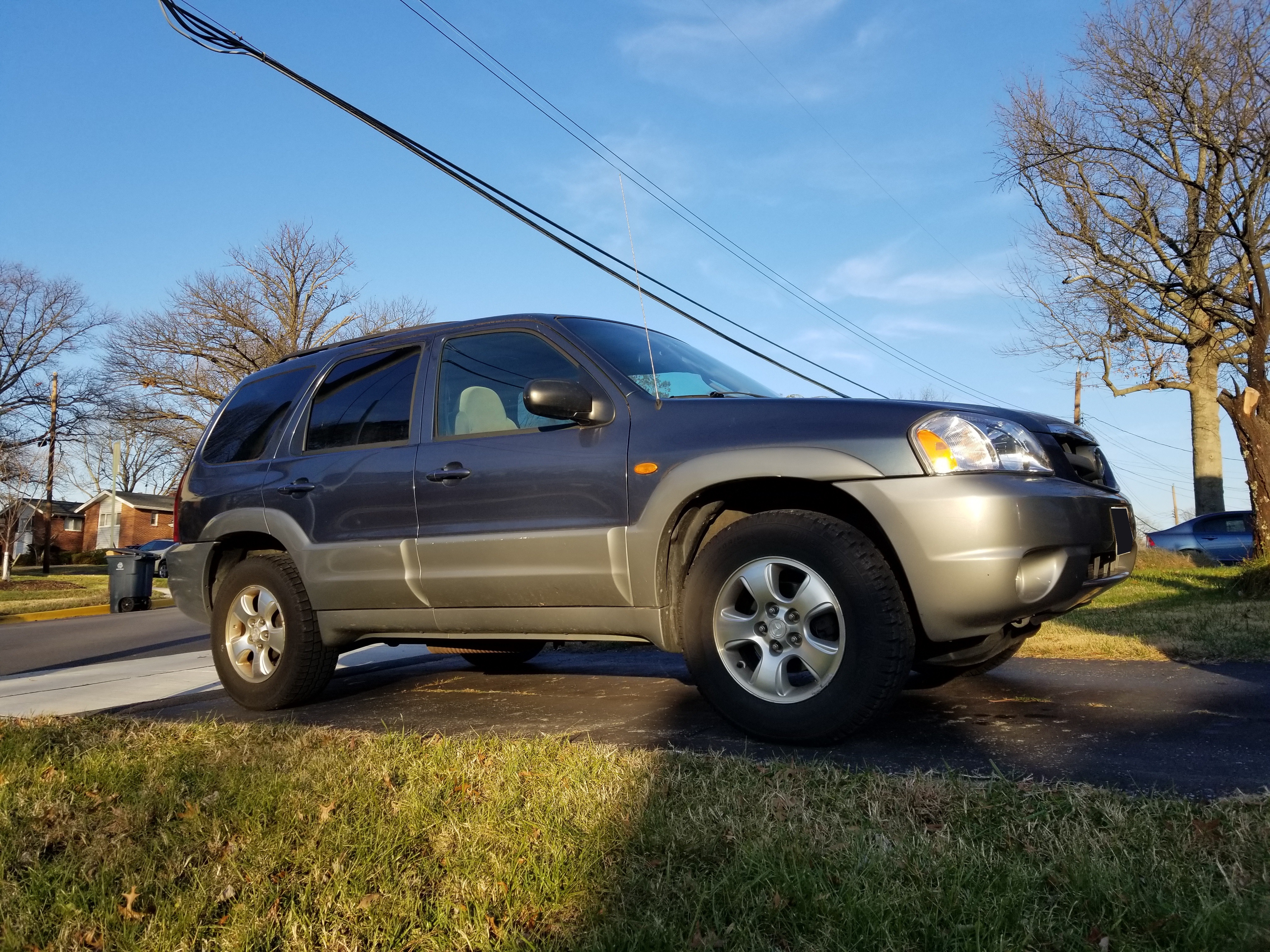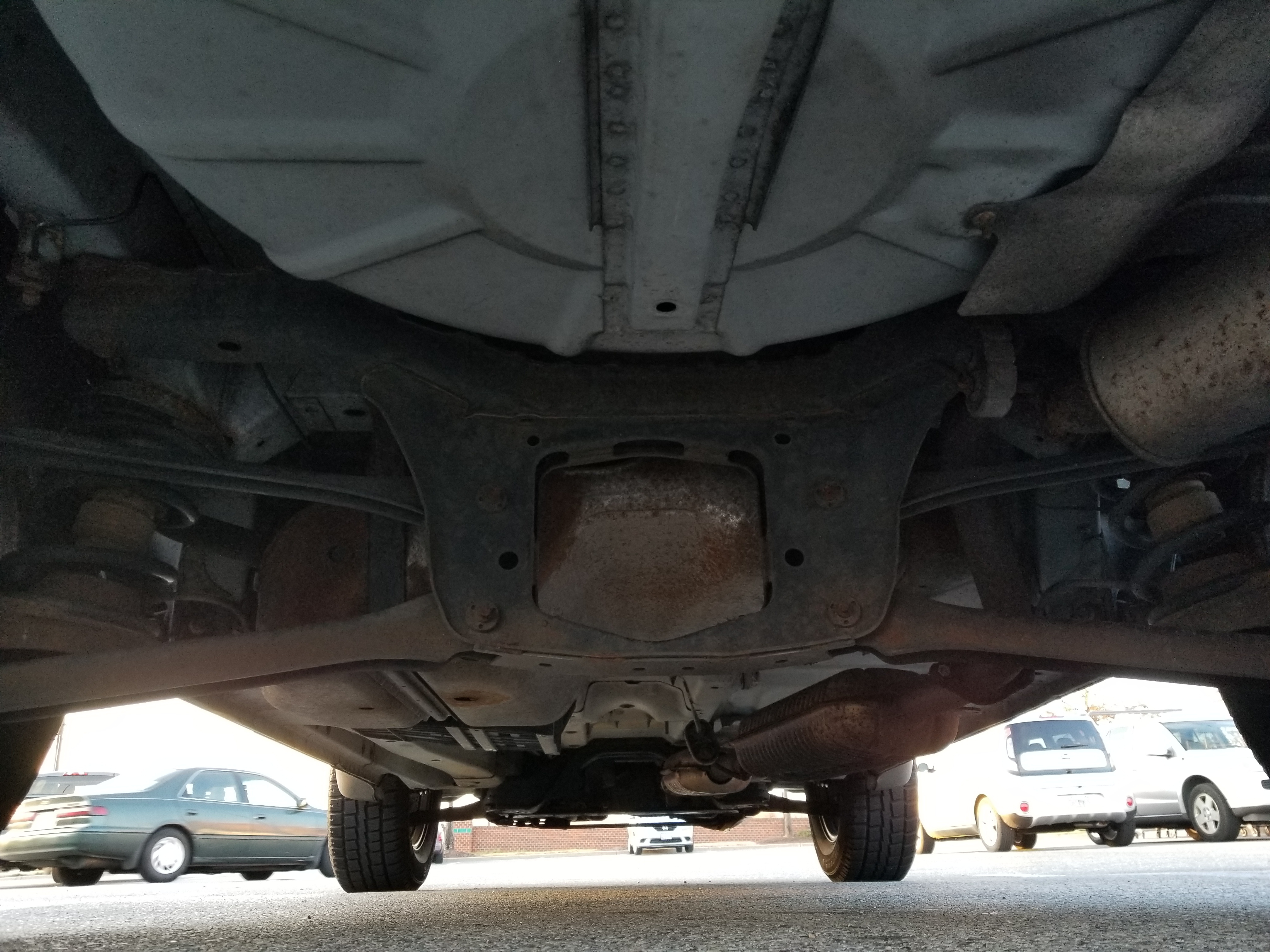
What is it?
When I first saw this Tribute I thought "the poor thing looks like a bootleg Ford Escape," and then ate my words as soon as I found that the Tribute and Escape are in fact exactly the same car. Every time I try to say Mazda Tribute, I almost say Ford Escape instead. Both the Tribute and Escape were the product of a collaboration between Ford and Mazda in the early 2000s, a marriage that also produced the Ford Probe, and resulted from a collective desire from both manufacturers to make a modern and relevant crossover compact SUV. Did it work? I don't know.
The Tribute ends up being a "crossover" not because of its looks or its styling; it really isn't just a jumped up hatchback like many modern crossovers are; rather, it used a Mazda floorpan design along with a powertrain developed jointly with Ford to make a monocoque SUV with a transverse engine and transaxle. Why did they do that? I don't know.

What is it like?
The Tribute isn't a very big SUV, but it has the boxy lines of its larger siblings like the contemporary Ford Explorer. Unlike the Explorer, it uses a lighter monocoque chassis that belies its road car origins; though all SUVs are ultimately made to cheat CAFE regulations by being built as light trucks, the Tribute has very little truck-ishness about it. Like other early 2000s SUVs and crossovers, the Tribute doesn't put much effort into looking good; as this was still a time when the Utility in Sport Utility Vehicle really mattered, it was more than acceptable to have it be boxy and businesslike, as opposed to the heavily stylized crossovers of today. The "Sport" comes through in the plastic lower body panels and more aggressive-looking headlights and grille that the Escape forwent, in favor of familiar blocky Ford styling. Mazda had a reputation to uphold with the Tribute, after all. Did it succeed? I don't know.
Another crucial difference the Tribute has against its bigger brother the Explorer is its suspension; the Explorer is a good stodgy old body-on-frame truck with a live rear axle, while the Tribute has fully independent suspension, front and rear; in the rear this was likely done so as to maximise parts commonality between the front wheel drive and all wheel drive variants; the only difference between the two on the rear end is the fact that one has got a propeller shaft and differential under and the other hasn't; all of the actual suspension linkages are common with both. It's not the cute, low-slung multilink suspension of the Civic though; the Tribute has a unitized long-travel multilink suspension with nice big coil springs that is installed as a single unit onto the monocoque body. This means that unlike some crossovers, the Tribute really does have an actual SUV suspension. Jeep purists will scoff and say that anything without two live axles and multiple Panhard rods or Watts linkages aren't real offroaders but they forget the caveat here: the Tribute isn't an off roader. It really isn't. It's built on a sedan platform with a transverse engine and 4WD as an option. It's a road car that happes to have some SUV components. So, unlike a Jeep, the Tribute isn't going to be a great offroader. However, with its 200hp V6 and light monocoque body, it'll be great on roads, won't it? Or it'll at least be comfortable on roads, right? You'll see.

The Tribute is reasonably spacious inside, and has front bucket seats separated by a center console for ample cupholding and CD storage space. The front seats have integrated headrests that were made for people with shorter spines than myself; I found myself worried about the car's ability to prevent me from snapping my neck in a forward collision. Strangely, it has a column shifter, but a console parking brake, which I found a disorienting combination. My old third-generation Dodge Caravan Sport had a column shifter, but a pedal parking brake that left a huge amount of open space free between the front seats; the Tribute was given the truck-style shifter but then doesn't have the free space it might if it had a pedal parking brake. I sincerely do not understand why Mazda/Ford did this, but as with all cars, you get used to it. At least it isn't as confusing as the Kia Niro, that has a console shifter but a pedal parking brake.
The Tribute is pretty easy to get into because of its high stance and its trunk is generously sized, and the one I drove had an aftermarket CD/DVD player that made it a little easier to work the stereo. The seats are comfortable enough, and the upright sitting position and big steering wheel, as well as good visibility, make it easy to drive. Overall, the Tribute functions as a pretty decent crossover, from the days when "crossover" either meant whatever the Aztek/Rendezvous were supposed to be, or meant monocoque, front wheel drive small SUV.
How does it drive?
It drives...like an SUV. The monocoque design that does away with a heavy chassis frame doesn't really make it any lighter, and the steering wheel is loose at all speeds, but the power assist makes two-finger driving a possibility. The vague steering wheel is complemented by the loose suspension that soaks up all kinds of bumps; the Tribute actually seems happy on rough, little-maintained roads, as its soft springs and long-travel suspension eat up even the deepest potholes. The jerkiness of rough roads is little diminished, but there is much less bouncing and worryingly heavy thumping than lighter cars like my Civic experience.
The soft, high suspension of the Tribute naturally lends it to not want to corner; the rollover risk sticker on the visor says everything you need to know. Body roll happens and the car doesn't really seem to want to keep its grip, but let's be honest with ourselves; nobody who buys an SUV is interested in cornering. The Tribute's one saving grace is its fully independent suspension, which is probably less likely to make emergency maneuvers result in a rollover than a larger or more specialized SUV's live beam axles. Emergency maneuvers might indeed be necessary; the brakes are decent, but can't shake the fact that the car is quite heavy, and between the weight and the rear drums, heavy braking on downhills could quite likely lead to brake fade. Fortunately, the overdrive lockout is an easy to reach toggle button that makes engine braking easier.
The Tribute I reviewed came with the 3.0L Duratec V6, developing 203hp. The V6's extra 50 hp over the I4 option doesn't seem like it matters too much though, except for high-tourque applications like towing and off-roading where the car is stuck in first all the time. The somewhat apathetic transmission eats up the engine's revs and prevents the car from really accelerating too hard; putting your foot down results in the throaty V6 roar and...marginal acceleration. I think getting the I4 version with the 5-speed manual would actually be quicker than the 4-speed auto with V6 engine. But again, remember the car we're talking about; this isn't a sporty grand tourer or an offroader begging for boulders; it's a road-going light SUV. Handling isn't really a concern, acceleration is neither expected nor provided, and power is useful insofar as it makes you better able to haul whatever you need, when you need to. The Tribute gets decent city gas mileage, quoted at about 23mpg, and the later hybrid version probably does even better. This isn't great, and highway gas mileage is actually quite bad, but for in-town trips, it's certainly good enough, especially considering how much space you have.

Who is it for?
I spent the entire time i drove the Tribute wondering who Mazda sold it to when it was new. It isn't made to be an offroader, but it's still tall, top-heavy, and hefty. It doesn't get amazing gas mileage, partly due to its big, slow-revving V6, but its mileage also could be a lot worse. It doesn't really accelerate, largely due to its transmission, but also partly because of its weight; but the engine offers a good deal of torque which probably makes the Tribute pretty good at towing if it really had to. It has a lot of space inside, but the floor is extremely high off the ground, which is both good and bad for ease of loading. The Tribute is basically a taller minivan with less space and worse handling. Who the hell is this car for?
It's for workers and old folks. Think about it; the elderly don't care so much about handling and braking, since they don't drive too fast, and they do enjoy having seats that are high off the ground and easy to get into and out of. They certainly enjoy having lots of space for...whatever it is they do, and having a V6 option harkens back to the old days of high-displacement, slow engines that were the hallmark of true American cars.
On the other hand, the Tribute has a lot of space, it's pretty efficient, has more than enough torque for light towing and hauling, and its tall suspension lets it handle dirt roads better than a normal car might; throw in the all wheel drive option and I'm certain the Tribute would shrug off any dirt road short of a rocky fire road. This makes the Tribute/Escape an appealing option for both fleet service and for individual use for contractors, utility workers, and other salt-of-the-earth types who need a light truck but want it to be comfortable and have an enclosed cargo area and four seats. The zero-effort driving style and good in-city mileage make the Tribute a reasonable choice for anybody who prioritizes space and comfort over performance.
The Tribute/Escape isn't a bad SUV; on the contrary, it's a fine example of what SUVs truly are when you peel off the aggressive branding. Maybe that doesn't mean it's a good car, but for a lot of people, it's definitely good enough.